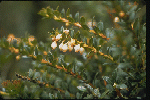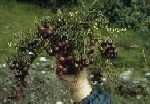References: SLEUMER, H. O., Revision der Gattung Pernettya Gaud. Notizbl. Bot. Gart. Mus. Berlin-Dahlem 12: 626--655 (1935). -- CAMP, W. H., Studies in the Ericales IV. Notes on Chimaphila, Gaultheria and Pernettya in Mexico and adjacent regions. Bull. Torrey Bot. Cl. 66: 7--28 (1939). -- SLEUMER, H. O., Taxonomy of the genus Pernettya Gaud. (Ericaceae). Bot. Jahrb. Syst. 105: 449--480 (1985). -- BAAS, P., Comparative leaf anatomy of Pernettya Gaud. (Ericaceae). Bot. Jahrb. Syst. 105: 481--495 (1985). -- MIDDLETON, D. & C. C. WILCOCK, A critical examination of the status of Pernettya as a genus distinct from Gaultheria . Edinburgh J. Bot. 47: 291--301 (1990). -- LUTEYN, J. L., Pernettya , in J. L. LUTEYN (ed.), Ericaceae--Part 2. The superior-ovaried genera (Monotropoideae, Pyroloideae, Rhododendroideae, and Vaccinioideae p.p.). Flora Neotrop. Monogr. 66: 365--383 (1995).


Repent, procumbent, or erect shrubs, rarely cushion plants, bisexual or by abortion of pollen or ovules unisexual, then dioecious or gynodioecious; stem puberulous, rarely glabrous, usually also moderately to densely strigose or setose with basally swollen, ferruginous; indumentum of simple to multicellular, multiseriate, straight or sometimes crisped sometimes glandular-tipped hairs. Leaves alternate, evergreen, coriaceous, apex obtuse or midrib protracted into an achlorophyllous mucro, margin entire or often subserrate-crenulate, the teeth then bristle-tipped with short to long, eglandular or glandular-tipped hairs, glabrous or rarely setose beneath; pinnately nerved; short petiolate. Inflorescence axillary, the flowers usually solitary in upper leaves or rarely racemose (only P. marginata in the Guayana Highland and P. insana in temperate S. America), the leaves sometimes reduced and congested and then the flowers pseudo-racemose; pedicel with 2-many bracteoles along the length nearly to apex, glabrous or puberulous, sometimes also shortly strigose or setose with gland-tipped hairs. Flowers 5-merous, nodding, without odor; aestivation imbricate; calyx articulate with pedicel, persistent, parted nearly to base, glabrous, the lobes lanceolate to elliptic, acute, often ciliate, normally membranous and not accrescent in fruit, rarely 1--5 becoming succulent after anthesis, then remaining at base of fruit, rarely accrescent to lower half of fruit (in some southern hemisphere, temperate species); corolla urceolate, cylindric to ovoid or subglobose, white or white tinged with pink or rose, glabrous, the lobes reflexed, deltate, acute to obtuse, less than 1/10 as long as the corolla tube; stamen (8--) 10, about 1/2 as long as the corolla; filaments distinct, slightly to conspicuously dilated above the base, papillate, glabrous to pilose, lacking spurs; anthers distally 4-awned, the awns 0.4--0.5 mm long, sometimes vestigial, disintegration tissue present dorsally at base of awns; thecae 0.8--1.5 mm long, dehiscing apically by terminal pores; pollen lacking viscin threads; ovary superior, 5-locular, glabrous to densely short-pilose; style 2--3 mm long, glabrous. Fruit a berry, subglobose to globose, apically depressed, dark blue-black, rarely light purple to almost white, glabrous to densely short-pubescent; seeds wingless, numerous, small, angular, compressed, ca 1.2 mm long; testa impressed-punctate. Chromosomes: x=11.
A genus of about 14 closely related species fide SLEUMER (1985) occurring in Tasmania and New Zealand (5 spp.), temperate South America (Chile and Argentina, 5 spp.), and Mexico, Central and South America (4 spp.).